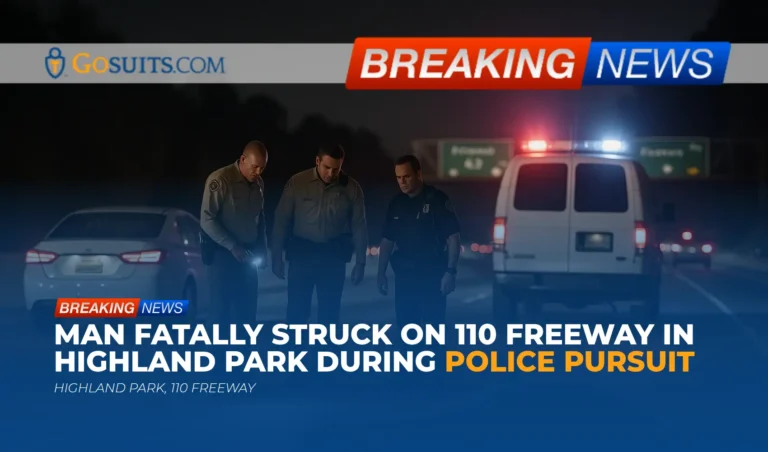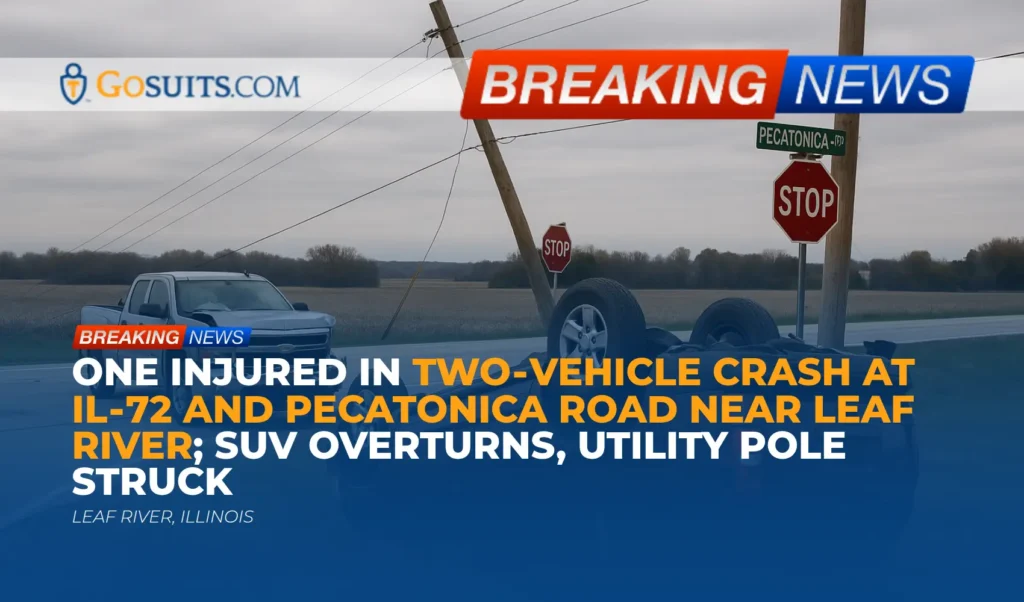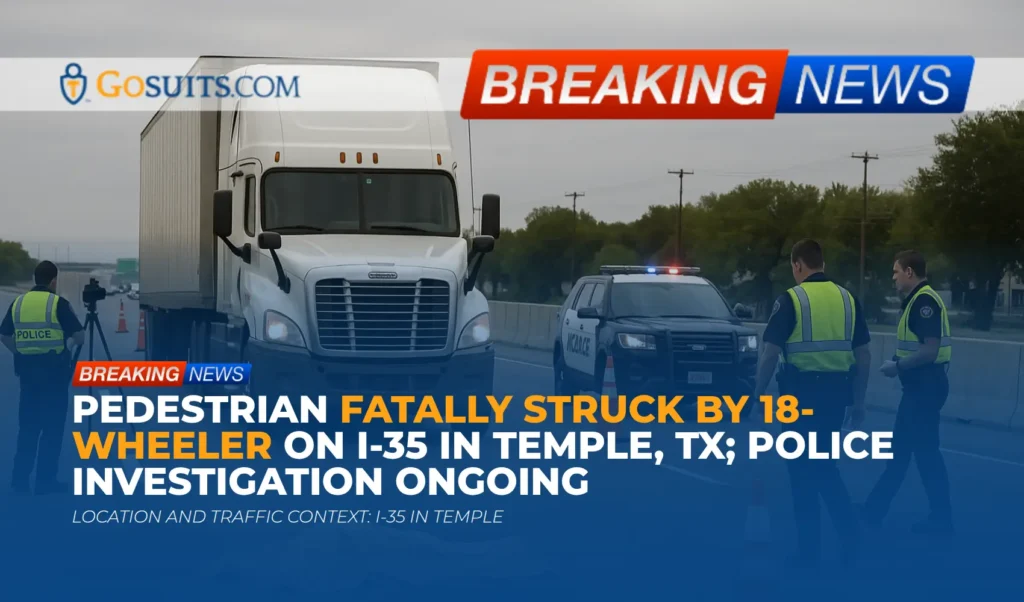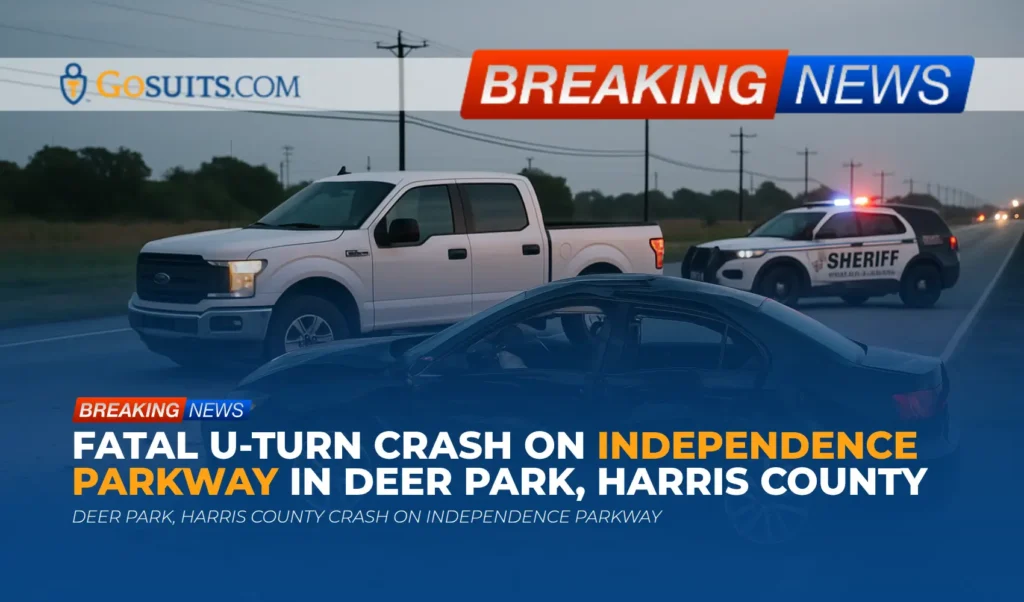- What we know about the Highland Park 110 Freeway fatality
- Location, traffic impacts, and what witnesses reported
- Why pedestrian strikes on freeways are so devastating
- Agencies likely involved and how records are handled
- How families can obtain official information and documents
- California civil legal context after a pursuit-related freeway death
- Insurance considerations that may arise
- Practical steps to preserve rights and evidence
- Key timelines and deadlines under California law
- Safety and policy considerations about vehicle pursuits
- Commentary from Gosuits Los Angeles, California Personal Injury Attorney
- Call-to-action: What to do next and why timing matters
What we know about the Highland Park 110 Freeway fatality
A man was struck and killed by a car on the Arroyo Seco Parkway, the 110 Freeway, near Highland Park on Monday night. According to reports, law enforcement officers were in pursuit of a white van traveling northbound in the number 1 lane. As the chase approached traffic, the driver stopped, exited the van, and crossed over the center divider toward southbound lanes. Shortly after he reached the southbound side near Avenue 43, a southbound vehicle struck him, and his body was propelled off the roadway. Authorities closed all northbound lanes of the 110 south of Avenue 52 and all southbound lanes north of Avenue 43 to investigate and manage the scene. Officials did not state why the driver was being pursued, and his name has not been released pending identification and next-of-kin notification.
These are the confirmed elements available at this time. There are unanswered questions that official investigations typically address, such as the exact speeds involved, lighting and visibility, the time gap between the subject entering the southbound lanes and the strike, actions of all drivers in the vicinity, and whether any vehicle cameras, traffic cameras, or law enforcement dash cameras captured the sequence.
Location, traffic impacts, and what witnesses reported
The incident occurred in the Highland Park area of Los Angeles on the 110 Freeway near Avenue 43. The closures stretched to Avenue 52 on the northbound side, indicating a substantial collision and scene perimeter. Freeway closures of this size usually allow investigators to conduct measurements, document evidence, and reconstruct events.
Witness accounts often vary in high-speed and high-stress conditions. Investigators will look for consistent facts such as lane positions, skid or yaw marks, debris fields, point of impact on the vehicle and roadway, and the timing of the pursuit relative to traffic density. If nearby vehicles had dash cameras, that footage could be important to clarify how quickly the man entered southbound lanes and whether the striking driver had any realistic opportunity to avoid the collision.
Why pedestrian strikes on freeways are so devastating
Pedestrian crashes on controlled-access highways are among the deadliest roadway events. Freeway speeds reduce reaction time and increase stopping distances dramatically, which can make avoidance nearly impossible when a person appears in a travel lane without warning. The narrower sightlines created by curves, grade changes, and lighting conditions add risk, particularly at night.
Federal transportation safety resources note that pedestrian fatalities remain a serious concern nationally, and the risk is magnified in high-speed environments like freeways. For general pedestrian safety information, see the National Highway Traffic Safety Administration’s guidance on pedestrian safety at nhtsa.gov. While most pedestrian safety campaigns focus on surface streets, the physics of high-speed impacts on freeways illustrates why incidents like this often cause catastrophic or fatal injuries even when a driver is attentive and sober.
Agencies likely involved and how records are handled
On California freeways, the primary traffic collision investigation is often handled by the California Highway Patrol. Depending on jurisdiction and mutual aid, a municipal department may be involved in a pursuit that transitions onto a freeway, but collision documentation typically follows CHP protocols. The Los Angeles County Department of Medical Examiner handles decedent identification, cause and manner of death determinations, and next-of-kin notification. Caltrans manages freeway closures and traffic control during and after the incident.
Key agencies and their typical roles include:
- California Highway Patrol – Traffic collision report, scene documentation, and investigative follow up. General information and public records guidance is available at chp.ca.gov.
- Los Angeles County Department of Medical Examiner – Case records, autopsy and toxicology reports, and decedent affairs support. Family-facing resources are at me.lacounty.gov.
- Caltrans – Traffic management and closures, with live updates on Caltrans QuickMap.
- Los Angeles County District Attorney’s Bureau of Victim Services – Support services for victims and survivors of incidents under investigation, available at da.lacounty.gov/victims.
Record handling varies by agency and case status. Collision reports are generally released to parties in interest, such as involved drivers and next-of-kin. Coroner records are released in accordance with county policy and California law.
How families can obtain official information and documents
Accessing accurate, official documents can help families understand what happened and meet administrative needs that arise after a sudden loss. The following are common records and where they typically come from in Los Angeles County.
Traffic collision report
Freeway collisions are often documented by the California Highway Patrol using a standardized collision report. Parties in interest, which can include legal next-of-kin, may request a copy. Instructions for requesting collision reports are provided by CHP at chp.ca.gov/notify-chp. Requesters should be prepared to provide the date, approximate time, location, involved vehicle information if known, and proof of relationship.
Coroner case updates, autopsy, and toxicology
The Los Angeles County Department of Medical Examiner manages identification, cause and manner of death determinations, and release of remains. Families can find guidance on case records, report requests, and support services at me.lacounty.gov. The office explains how to request copies of reports, what documentation is required, and when reports typically become available.
Road closure and traffic confirmation
For confirmation of closure times and locations, Caltrans provides real-time and recent closure data via QuickMap. Although these tools are primarily for travel, timestamps and closure extents can provide helpful context for understanding the scope and duration of an incident response.
Public records considerations
California’s Public Records Act permits the public to request certain government records, subject to exemptions. While active investigations and personal privacy limitations may restrict some content, agencies provide instructions for lawful access. General court and judicial resources are available through the California Courts at courts.ca.gov, which can help orient families to documentation that might be used if a civil case is pursued later.
California civil legal context after a pursuit-related freeway death
Every incident is unique, and outcomes depend on facts developed through investigation. The following general principles can help frame how civil liability is often analyzed in a pursuit-related fatality on a freeway. This information is educational and not a directive for any specific case.
Pedestrian presence on a freeway
California law allows authorities to restrict pedestrians from freeways and expressways. Many freeways in Los Angeles are posted to prohibit pedestrians for safety. See California Vehicle Code section 21960 at the state’s legislative information site: leginfo.legislature.ca.gov. When a person is in a travel lane of a freeway, drivers approaching at speed may have no realistic opportunity to avoid a collision, particularly at night or around curves.

Comparative fault and the duty of care
California uses comparative fault principles in civil cases, which means a finder of fact can assign percentages of responsibility among those whose actions contributed to an event. The Judicial Council of California’s civil jury instructions discuss comparative fault and the duty of reasonable care; resources are available at courts.ca.gov. In a scenario where a person suddenly appears in freeway lanes, determinations about whether a driver breached a duty of care will focus on reaction time, reasonable speed for conditions, lighting, driver attentiveness, and whether evasive options were available without creating greater danger.
Liability considerations for the striking driver
If a driver could not reasonably avoid a collision because a person entered the roadway unexpectedly at freeway speeds, that driver may not be civilly liable. If evidence later shows excessive speed, impairment, distraction, or other negligent behavior by the driver, that can change the analysis. Objective evidence such as onboard vehicle data, dash camera footage, and physical roadway evidence often becomes crucial.
Law enforcement pursuits and governmental immunity
California law provides certain immunities to public entities and officers for damages resulting from vehicle pursuits, provided the agency has a compliant, adopted vehicle pursuit policy and meets training and reporting requirements. See California Vehicle Code section 17004.7 at leginfo.legislature.ca.gov, which outlines the conditions for immunity. Additionally, the California Commission on Peace Officer Standards and Training publishes recommended Vehicle Pursuit Guidelines available at post.ca.gov.
Whether a public entity can be held liable in a particular incident is highly fact dependent and may involve analysis of policy compliance, dispatch and supervisory decisions, risk assessment during the pursuit, and the causal chain between pursuit activity and the fatal event.
Wrongful death and survival claims
California recognizes two distinct civil actions after a fatality:
- Wrongful death by eligible heirs for their own losses, governed by Code of Civil Procedure section 377.60 at leginfo.legislature.ca.gov.
- Survival action by the decedent’s estate for certain losses the decedent sustained before death, under Code of Civil Procedure section 377.30 at leginfo.legislature.ca.gov.
Damages in a wrongful death action typically include loss of financial support, loss of consortium and companionship, and related harms suffered by qualifying family members. Survival actions may include medical expenses incurred before death and other permitted damages.
Insurance considerations that may arise
Insurance can be complex in pursuit-related freeway fatalities. Points commonly reviewed include:
- Liability insurance of the striking driver – If a driver is found negligent, their auto liability policy may respond to claims by eligible heirs. If the driver is not negligent, their policy may still become relevant for property damage or first-party coverages.
- Uninsured or underinsured motorist – These coverages apply when an at-fault motorist lacks adequate insurance. They are not generally applicable where the striking driver is not at fault. The details of the policy language matter.
- Medical payments coverage – Some California auto policies offer optional medical payments coverage that can help with immediate expenses, regardless of fault, subject to policy terms.
- Household and life insurance – Separate from auto coverage, life or accidental death and dismemberment policies may be relevant to a family’s financial stability after a sudden loss.
Before speaking with any insurance carrier about the facts of the incident, it is prudent to consult with a qualified attorney. Statements made to insurers can be recorded and later used to shape liability determinations.
Practical steps to preserve rights and evidence
Evidence can disappear quickly after a freeway fatality. Consider these practical measures to safeguard information and maintain options while the investigation unfolds.
- Request official records – Initiate requests for the traffic collision report through CHP and for case information through the Los Angeles County Medical Examiner. The earlier these processes begin, the sooner families can review foundational facts.
- Secure available video – If any witnesses have dash camera or phone video, politely ask them to preserve it. Time stamps, raw files, and original memory cards can be important. Nearby businesses and residences along elevated freeway sections sometimes capture audio or visual clues; identify potential cameras and request preservation where appropriate.
- Document the scene context – Note lighting conditions, weather, and any unusual roadway or construction factors. Caltrans closure logs and QuickMap screenshots can corroborate timing.
- Identify responding units – Keep a list of agencies on scene, approximate arrival times, badge numbers if known, and any incident numbers provided. This helps streamline follow up.
- Be cautious with insurers – Consult an attorney before contacting any insurance company about the incident. What is said to an adjuster can be used later and may affect liability assessments.
Key timelines and deadlines under California law
California sets strict deadlines for civil claims. Missing a deadline can limit or eliminate legal options. The following general deadlines appear in California law; specific situations can differ, especially where public entities are involved.
- Wrongful death statute of limitations – In most cases, two years from the date of death. See Code of Civil Procedure section 335.1 at leginfo.legislature.ca.gov.
- Claims against public entities – A written government claim usually must be presented within six months of the incident for personal injury or wrongful death claims under Government Code section 911.2 at leginfo.legislature.ca.gov. If the claim is rejected, a lawsuit is commonly due within six months of the rejection notice under Government Code section 945.6 at leginfo.legislature.ca.gov.
- Pursuit policy immunity prerequisites – Public entity immunity for damages from pursuits depends on compliance with Vehicle Code section 17004.7, including an adopted policy and training elements. The statute is published at leginfo.legislature.ca.gov.
These laws are detailed and can be difficult to apply without reviewing the facts. Consulting with counsel promptly helps ensure applicable deadlines are calculated correctly and that claim forms are timely filed where required.
Safety and policy considerations about vehicle pursuits
Pursuit decisions require quick judgments about public safety. California’s policy framework encourages agencies to weigh the risks of continuing a pursuit against the need to apprehend, especially in dense urban areas and near freeway traffic. The California Commission on Peace Officer Standards and Training provides Vehicle Pursuit Guidelines that address risk assessment, supervisory oversight, tactics, and termination criteria. These guidelines are available at post.ca.gov.
In civil evaluations, questions sometimes include whether speed and traffic conditions warranted disengagement, whether air support was available, whether containment strategies could reduce risk, and whether communication among units met policy. These are high-stakes, fact-specific analyses that often rely on dispatch audio, CAD logs, and policy documents.
Commentary from Gosuits Los Angeles, California Personal Injury Attorney
Our hearts go out to everyone affected by the fatal incident on the 110 Freeway near Highland Park. Sudden losses on our roadways leave families searching for answers during a time of shock and grief. This commentary is offered for general information to help the community understand the kinds of questions and processes that typically follow.
Based on what is publicly reported, a driver fleeing a pursuit left his vehicle and crossed into southbound lanes, where he was struck by a passing car. On high-speed freeways, events unfold in seconds. Whether any driver could avoid a person who appears in a live lane depends on distance, lighting, traffic, and options for evasive action that do not endanger others. Those conditions, together with data from responding agencies, will frame any civil analysis.
In our experience, insurance companies and large entities often move quickly to shape the narrative after a serious crash. Adjusters may seek recorded statements or press for details before people have had a chance to review official reports or consult counsel. Policies contain technical terms that affect rights in unexpected ways. Without guidance, people can inadvertently accept characterizations of fault that are incomplete or inconsistent with later evidence.
Speaking with a seasoned attorney early can help clarify rights, protect against missteps in conversations with insurers, and ensure critical evidence is preserved. Many firms offer a free consultation so families can ask questions and understand the road ahead before making any decisions.

Call-to-action: What to do next and why timing matters
Act promptly to secure information and safeguard options. The immediate hours and days after a freeway fatality are when evidence is most likely to be preserved and when key deadlines begin to run.
- Start the records process – Initiate requests for the CHP collision report and the Medical Examiner’s case records. Having the official documents helps separate fact from rumor and informs any later decisions.
- Preserve evidence now – Identify and save any videos, photos, or witness contacts. Ask potential witnesses to keep original files and refrain from deleting or overwriting content.
- Document communications – Keep a log of every contact with agencies and insurers, including dates, names, and summaries. Organized notes reduce stress and prevent key details from slipping through the cracks.
- Avoid premature insurer statements – Do not provide recorded statements or written summaries to any insurance company before consulting with an attorney. Statements can be taken out of context and used to limit recovery.
- Calendar deadlines – Note potential claim and lawsuit timelines, especially the six-month government claim requirement that can apply when public entities are involved. Missing a deadline can permanently close the door on certain claims.
- Seek qualified guidance – A free consultation can clarify whether there are viable civil claims, identify responsible parties, and outline a plan to protect rights while investigations are ongoing.
Where to obtain help and information
- Traffic collision report – California Highway Patrol provides instructions for requesting collision reports at chp.ca.gov/notify-chp.
- Autopsy and coroner records – Los Angeles County Department of Medical Examiner information for families is at me.lacounty.gov.
- Traffic closures and travel impacts – Caltrans QuickMap at quickmap.dot.ca.gov shows lane closures and traffic conditions.
- Victim support services – Los Angeles County District Attorney’s Bureau of Victim Services provides assistance and resources at da.lacounty.gov/victims.
Referenced laws and guidance
- Wrongful death limitations period – Code of Civil Procedure section 335.1 at leginfo.legislature.ca.gov.
- Survival and wrongful death statutes – Code of Civil Procedure sections 377.30 and 377.60 at leginfo.legislature.ca.gov.
- Government claims deadlines – Government Code sections 911.2 and 945.6 at leginfo.legislature.ca.gov.
- Pursuit immunity prerequisites – Vehicle Code section 17004.7 at leginfo.legislature.ca.gov, and California POST Vehicle Pursuit Guidelines at post.ca.gov.
- Pedestrian access restrictions on freeways – Vehicle Code section 21960 at leginfo.legislature.ca.gov.
- General pedestrian safety information – National Highway Traffic Safety Administration at nhtsa.gov.






